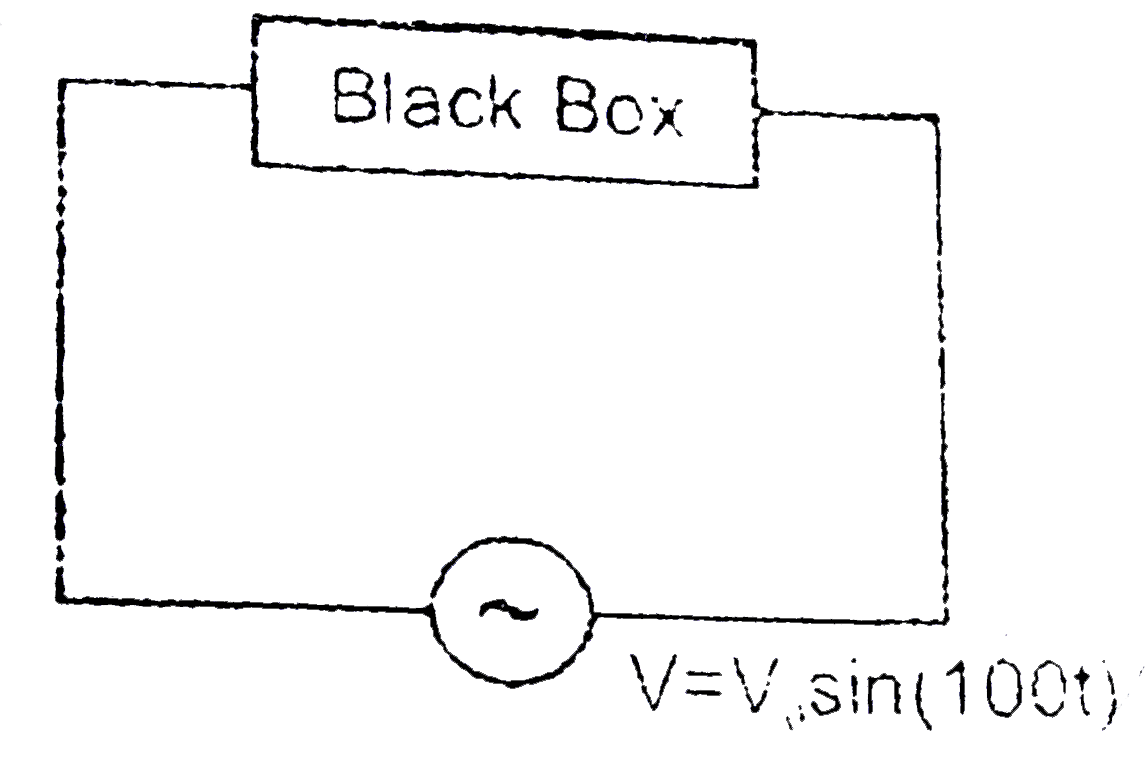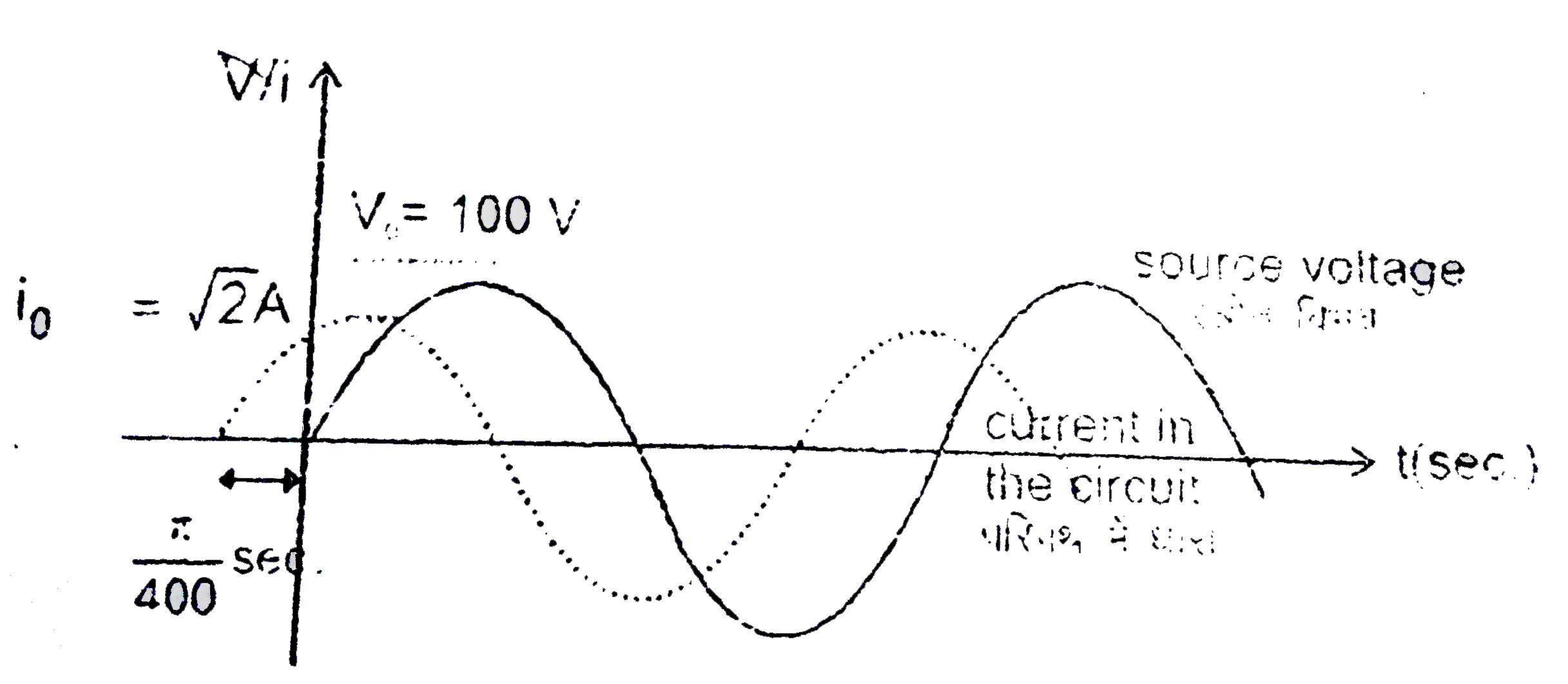In an AC series circuit, the instanctaneous current is zero when the instantaneous voltage is xamimum. Connected to the source may be a
pure capacitor
pure inductor
combination of pure an inductor and pure capacitor
pure resistor
The correct Answer is:A,B,C
To solve the question regarding the AC series circuit where the instantaneous current is zero when the instantaneous voltage is maximum, we will analyze each option provided in the question systematically.
1. Understanding the Problem:
- We need to identify which component (pure capacitor, pure inductor, combination of both, or pure resistor) satisfies the condition that the instantaneous current is zero when the instantaneous voltage is at its maximum.
2. Analyzing Pure Capacitor:
- In a pure capacitor, the phase difference between voltage and current is ϕ=π2 (90 degrees).
- This means that the voltage leads the current by 90 degrees.
- When the current is maximum, the voltage is zero, and when the current is zero, the voltage is maximum.
- Conclusion: The condition is satisfied for a pure capacitor.
3. Analyzing Pure Inductor:
- In a pure inductor, the phase difference is also ϕ=π2.
- However, in this case, the voltage lags the current by 90 degrees.
- Therefore, when the current is maximum, the voltage is zero, and when the current is zero, the voltage is maximum.
- Conclusion: The condition is satisfied for a pure inductor as well.
4. Analyzing Combination of Pure Inductor and Pure Capacitor:
- For a combination of pure inductor and pure capacitor, the phase difference can be expressed as ϕ=tan−1(XL−XCR).
- In the case of pure inductor and pure capacitor (where resistance R=0), the phase difference becomes ϕ=π2.
- This means that the behavior is similar to both pure inductor and pure capacitor, where the voltage and current relationship holds.
- Conclusion: The condition is satisfied for the combination of pure inductor and pure capacitor.
5. Analyzing Pure Resistor:
- In a pure resistor, the phase difference is ϕ=0.
- This means that the voltage and current are in phase; they reach their maximum and minimum values at the same time.
- Therefore, the condition that the instantaneous current is zero when the instantaneous voltage is maximum is not satisfied.
- Conclusion: The condition is not satisfied for a pure resistor.
Final Answer:
The components that satisfy the condition are:
- Pure Capacitor
- Pure Inductor
- Combination of Pure Inductor and Pure Capacitor
- We need to identify which component (pure capacitor, pure inductor, combination of both, or pure resistor) satisfies the condition that the instantaneous current is zero when the instantaneous voltage is at its maximum.
- In a pure capacitor, the phase difference between voltage and current is ϕ=π2 (90 degrees).
- This means that the voltage leads the current by 90 degrees.
- When the current is maximum, the voltage is zero, and when the current is zero, the voltage is maximum.
- Conclusion: The condition is satisfied for a pure capacitor.
- In a pure inductor, the phase difference is also ϕ=π2.
- However, in this case, the voltage lags the current by 90 degrees.
- Therefore, when the current is maximum, the voltage is zero, and when the current is zero, the voltage is maximum.
- Conclusion: The condition is satisfied for a pure inductor as well.
- For a combination of pure inductor and pure capacitor, the phase difference can be expressed as ϕ=tan−1(XL−XCR).
- In the case of pure inductor and pure capacitor (where resistance R=0), the phase difference becomes ϕ=π2.
- This means that the behavior is similar to both pure inductor and pure capacitor, where the voltage and current relationship holds.
- Conclusion: The condition is satisfied for the combination of pure inductor and pure capacitor.
- In a pure resistor, the phase difference is ϕ=0.
- This means that the voltage and current are in phase; they reach their maximum and minimum values at the same time.
- Therefore, the condition that the instantaneous current is zero when the instantaneous voltage is maximum is not satisfied.
- Conclusion: The condition is not satisfied for a pure resistor.
The components that satisfy the condition are:
- Pure Capacitor
- Pure Inductor
- Combination of Pure Inductor and Pure Capacitor
Topper's Solved these Questions
- ALTERNATING CURRENTBOOK - RESONANCE ENGLISHCHAPTER - ALTERNATING CURRENTEXERCISE - Exercise -2 Part-4
11 Videos
- ALTERNATING CURRENTBOOK - RESONANCE ENGLISHCHAPTER - ALTERNATING CURRENTEXERCISE - Exercise -3 Part-1
7 Videos
- ALTERNATING CURRENTBOOK - RESONANCE ENGLISHCHAPTER - ALTERNATING CURRENTEXERCISE - Exercise -2 Part-2
6 Videos
- ATOMIC PHYSICSBOOK - RESONANCE ENGLISHCHAPTER - ATOMIC PHYSICSEXERCISE - Advanved level problems
17 Videos
Similar Questions
In a circuit containing a capacitor and an AC source, the current is zero at the instant the source voltage is maximum. Is it consistent with Ohm's law?
View SolutionIn series LCR AC circuit, the voltage of the source at any instant is equal to
View SolutionAn inductor (L=200mH) is connected to an AC source of peak emf210V and frequency 50Hz. Calculate the peak current. What is the instantaneous voltage of the source when the current is at its peak value?
View SolutionAn inductor (L=200mH) is connected to an AC source of peak emf 210V and frequency 50Hz. Calculate the peak current. What is the instantaneous voltage of the source when the current is at its peak value?
View SolutionAn inductor (L=2000mH) is connected to an AC source of peak current. What is the instantaneous voltage of the source when the current is at its peak value?
View SolutionA voltage source V=V0sin(100t) is connected to a black box in which there can be either one element out of L,C,R or any two of them connected in series.
At steady state, the variation of current in the circuit and the source voltage are plotted together with time.using an oscilloscope, as shown
If AC source is removed, the circuit is shorted for some time so that capacitor is fully discharge and then a battery of constant EMF is connected across the black box, at t=0.The current in the circuit will-


View Solution(a) Draw graphs showing the variations of inductive reactnace and capacitive reactance with frequency of the applied ac source .
(b) Draw the phasor diagram for a series RC circuit connected to an ac source.
(c ) An alternating voltage of 220 V is applied across a device X , a current of 0.25 A flows , which lag behind the applied voltage in phase by π2 radian . If the same voltage is applied across another device Y , the same current flows but now it is in phase with the applied voltage .
(i) Name the devices X and Y.
(ii) Calculate the current flowing in the circuit when the same voltage is applied across the series combination of X and Y.

View SolutionIn a series L−R circuit, under which condition the power loss will be least for an a.c voltage source?
View SolutionA semiconducting device is connected in a series circuit with a battery and a resistance.A current is found to pass through the circuit .If the polarity of the battery is reversed, the current drops to almost zero.The device may be
View SolutionA semiconducting device is connected in a series circuit with a battery and a resistance.A current is found to pass through the circuit .If the polarity of the battery is reversed, the current drops to almost zero.The device may be
View Solution
